#entrainment
Text
The Sound of Bubbles

Every day I stand in front of my refrigerator and listen to the water dispenser pouring water into my glass. The skinny, fast-moving jet of water plunges into the pool, creating a flurry of bubbles. (Image credit: R. Piedra; research credit: M. Boudina et al.; via APS Physics)
Read the full article
#acoustics#bubbles#entrainment#fluid dynamics#instability#jets#physics#Plateau-Rayleigh instability#science
48 notes
·
View notes
Text
Experiencing Rhythms in the Body

Rhythm is a universal vibrational language. We respond to rhythm whenever we sense it and seek it out when it is not present, for we are innately rhythmic. Every rhythm has its own quality and touches you in a unique way. To experience this for yourself, try playing some different rhythms. Whether you drum or merely tap your fingers, learn to "feel the beat" by allowing it to sink into your body and consciousness. Notice how your body responds to each pattern. Keep in mind that the manner in which you play or shape a rhythm will affect your response. One of the paradoxes of rhythm is that it has both the capacity to move your awareness out of your body into realms beyond time and space and to ground you firmly in the present moment.
Begin by playing a steady, metronome-like rhythm with uniform time intervals. A clockwork drum beat generates a dynamic energy that is yang, creative, and expansive in nature. Dynamic energies are ascending forces that carry consciousness into higher realms. At a rapid tempo of three to four beats per second, a steady, rhythmic pattern, or "eagle-beat," will arouse and vitalize you. It creates the sensation of inner movement, which, if you allow it, will carry you along. As you continue to drum, you will become more ecstatic. You and your drum will seem to merge. You may speed up or slow down. That is perfectly normal. Shamanic trance is characterized by its range and flexibility, so don't get hung up on trying to maintain a certain speed. It can be distracting and your hands may get tired. Follow your inner sense of timing as to both tempo and duration.
After drumming the eagle-beat, simply relax and bathe in the sonic afterglow of physical and spiritual well-being. When the final drumbeat fades into silence, an inaudible, yet perceptible pulsation persists for a brief period. This silent pulse is ever-present within each of us, but our awareness is rarely in sync with it. Sense this silent pulse resonating within your body. You may experience the sensation of every particle in your body pulsing in sync with the rhythm you just played. This inner pulse entrains to the rhythmic pattern as soon as you begin to drum.
Next, try playing the steady pulse of a heartbeat rhythm. A two-beat rhythm produces a different sonic experience. The soft, steady lub-dub, lub-dub of a heartbeat rhythm has a calming and centering affect. It reconnects us to the warmth and safety of the first sound we ever heard -- the nurturing pulse of our mother's heartbeat melding with our own. According to Ted Andrews, author of Animal Speak, "a rhythm of two is a rhythm that helps connect you to the feminine energies of creative imagination, birth, and intuition." At a more rapid tempo, the heartbeat rhythm stimulates a downward flow of energy within the body. It generates a magnetic energy that is yin, intuitive, and receptive in nature. Magnetic energies are descending forces conducive to great healing, mind, and regenerative powers.
These two simple drum patterns are the healing rhythms I use most often in my shamanic work. Moreover, they are rhythm archetypes representing yin -- the form giving principle of energy, and yang -- the principle of life and consciousness immanent in all phenomena. Yin and yang are the binary elements that generate between them the totality of existence. A binary progression underlies the structure of reality. At a fundamental level, the laws of the universe are written in a binary code. The binary mathematical system forms the basis of computer languages and applies to nearly everything from crystalline structures to the genetic code. The binary basis of the genetic code is formed by the plus and minus strands of DNA.
The human experience is a microcosm and reflection of binary progression. The archetypes of rhythm are the fundamental patterns that underlie our resonant field of reality. Entraining to these archetypal rhythms, we experience them directly and discover our rhythmic interconnections. Each pattern pulsates specific qualities of energy that give inherent structure and meaning to the possibilities of being. They exist in every human being from the moment of conception to the final breath. Each human being is an integral composite of the archetypes of rhythm. Each of us is a series of rhythmic patterns summed up as a single inner pulse, the essential aspect of our being.
26 notes
·
View notes
Link
The resulting shift in my sense of time had a range of effects. I found it harder to pay attention to other events and processes that took longer or played out less sensationally even if I cared about them — like the local effects of climate change, grass-roots housing campaigns or even just the details of friends’ lives. I felt like my thoughts were running on shorter loops or never getting completed. Even my breaths were short, as though a full inhale couldn’t fit into such tiny intervals, and my joints would ache from a state of constant anticipation. It was the feeling of a furrowed brow, applied to my entire body. Most haunting was a sense that I had no substance, and that the physical world, with all its minute fluctuations and gradual changes, was somehow losing its color and texture.
In the past few years, in part because of how frayed my mind felt, I started avoiding my Twitter and Instagram feeds altogether. From this remove, I sat down and wrote out on paper what it was that I really wanted from these platforms. The answer ended up being a sense of recognition among peers, connection to people with shared interests and whose work I admire and the ability to encounter new, unexpected ideas. As opposed to algorithms, I wanted these new things to be recommended by individuals who had reasons to like them, like the weekly set on my local college radio station by a D.J. whose wide-ranging taste I’m at pains to describe, but reliably enjoy. Really, I think I just wanted everything to have a little more context.
With this in mind, I slowly started piecing something else together — at the time, a mix of emails, group chats and RSS feeds. But finding more context often means going more slowly and as I did so, I was confronted by my old habits and expectations around time and pacing. Information no longer came in through one nonstop fire hose, and even though that was precisely what I had complained about, the change made me uncomfortable and dissatisfied. Was something missing? The management scholar Allen C. Bluedorn has written that patterns of entrainment can persist in an organization long after the original zeitgeber is gone, and this is a bit like what happened to me. Years of inhabiting a temporal attitude had left a deep indentation on my mind, as if I were waking up early for a job I no longer had.
Over time, the indentation softened, and I got used to a different definition of what it meant to be connected. In the absence of the constant updates, signs of other tempos began to enter the picture: the migratory ducks arriving in the lake nearby, the long email from a friend that only comes once every few months and requires my full attention, the unglamorous city council meeting, the long, historical arc of something just now cresting in the news. My breathing, eating, sleeping body felt more real, with more traction among the sensory minutiae of the everyday. I even felt I could see further in both directions: into my past with all its failures and triumphs, and into the future where I might do something as-yet unimaginable. But what I’m describing is not a linear progression or a once-and-for-all kind of story. Now and then, I get remagnetized to that old clock and have to remember to step away.
2 notes
·
View notes
Text
Power of Brainwaves: Enhancing Wellbeing Through Neuro-Resonance
Check out my blog on The Power of Brainwaves: Enhancing Well-being Through Neuro-Resonance.
Did You Know??
We can train ourselves to tap into our different brainwave frequencies to manifest the lives we want and improve our quality of life. We can also use this skill to heal ourselves, gain clarity, and tap into our most creative selves to become successful!
There are five main types of brainwaves: Gamma, Beta, Alpha, Theta, and Delta. Each type is associated with different states of consciousness and cognitive functions.
How can we use brainwaves to improve our quality of life?
- Practicing mindfulness meditation can help regulate brainwave patterns, leading to increased alpha and theta activity associated with relaxation, stress reduction, and emotional well-being.
- Techniques such as binaural beats, isochronic tones, and audiovisual entrainment can synchronize brainwave patterns to induce desired states of consciousness, such as relaxation, focus, or sleep.
- Neurofeedback therapy uses real-time monitoring of brainwave activity to provide feedback and train individuals to self-regulate their brainwaves, leading to improved cognitive function, mood regulation, and overall well-being.
- Understanding the relationship between brainwave patterns and cognitive functions can inform strategies for cognitive enhancement, such as optimizing sleep patterns, managing stress, and practicing mental exercises to stimulate specific brainwave frequencies associated with memory, learning, and creativity.
- Integrating holistic wellness practices such as yoga, tai chi, acupuncture, and aromatherapy can modulate brainwave activity and promote a balanced mind-body connection, supporting overall health and vitality.
By harnessing the power of brainwaves and understanding how they influence our mental states and well-being, we can explore diverse strategies to optimize brain function, enhance cognitive performance, and cultivate a deeper sense of inner harmony and fulfillment in our lives.
For more information on how you can use your brainwaves to promote optimal health, cultivate the life you deserve, and manifest check out my blog.
Live Long & Prosper!
Remember our thoughts create our reality, and if we control our thoughts, we can control our reality!
https://theshamanicgoddess.com/.../power-of-brainwaves...
www.TheShamanicGoddess.com
Dr. Deilen Michelle Villegas, Ph.D.- Board Certified Holistic Health Practitioner, Traumatic Stress Expert, Trauma Recovery and Behavioral Health Specialist.
#brainwaves#mentalhacking#mindbodyspirit#neurofeedback#controlyourmind#healingthroughfrequencies#holisticwellness#manifestation#CheatCode#thinkaboutit#PowerfulMindset#wholebraindevelopment#jedimaster#MindBodyAlignment#creativity#GAMMA#alpha#Beta#theta#Delta#hypnosis#entrainment#guidedimagery#meditation#mindfulnesspractice
0 notes
Text
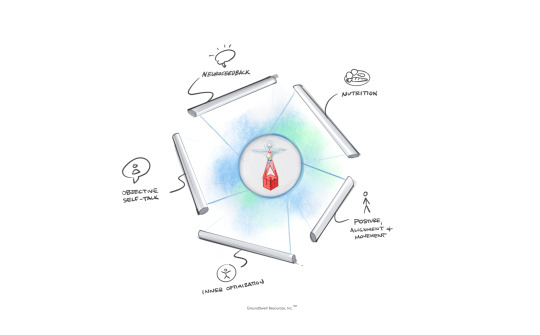
Based on over ten years of extensive research into peak performance and biohacking, we’ve selected and curated the most efficient and effective options and integrated them into our Intrapersonal Tensegrity℠ framework and offerings for owner-managers.
#GroundSwell℠#IntrapersonalTensegrity℠#BusinessOwnershipPlatform℠#BusinessOwnership#BusinessPartner#PeakPerformance#Biofeedback#Entrainment#Neurofeedback#Health#Biohacking#CorporateHealth#Movement#BodyAlignment#Nutrition#Posture#SelfTalk
0 notes
Text
Happiness and Flowstate Entrainment
The benefits of flowstate entrainment include:– Increased creativity and innovation– Improved overall well-being and life satisfaction– Increased cognitive processing speed– Improved learning and memory– Reduced stress and anxiety– Increased focus and concentration– Increased motivation and productivity– Increased self-esteem and confidence– Increased resilience and adaptability– Increased…

View On WordPress
#Conscious Collective#effortless#entrainment#Flow-state#fulfillment#Happiness#Headology#lifestyle#meaning#mindU#relevance
1 note
·
View note
Photo

Today’s Biodynamic Meditation was about sensing the tide surging in its midline pathway…surging toward my crown chakra, then surging toward my root chakra, and repeating that pattern for about 10 minutes. This pathway is our body’s main energy channel. My sense of it has strengthened over time. It touches the 7 major chakras. I believe it helps balance and energize them. It seems to have a function of regulation. It’s stronger when we’re healthier, and we can cultivate our health by strengthening it. Wow, what if a university lab decided to investigate this? Know anyone? There are a couple of ways to learn how to sense it. One way is by using self-awareness of the midline, seeking sensations of motion and direction until you sense them. The other way is doing the above, along with entrainment to someone with strong awareness of their own tide. The rest of my session was again with a cranial stillpoint, more in the midline of my cranium, and my third eye chakra was wide open. #biodynamicmeditation #selfhealing #meditation #tide #midline #chakras #balance #energy #health #regulation #healingfromtheinsideout #entrainment #research (at Austin, Texas) https://www.instagram.com/p/Cl83-Y4u-fz/?igshid=NGJjMDIxMWI=
#biodynamicmeditation#selfhealing#meditation#tide#midline#chakras#balance#energy#health#regulation#healingfromtheinsideout#entrainment#research
0 notes
Text
Die Hypnose
Die Hypnose – als Beispiel für eine praktische Anwendung des Paradigmas des “embodiment” und “embededdness”
Abstract
Der folgende Essay soll die Hypnose als Beispiel für eine praktische Anwendung des Paradigmas des “embodiment” und “embededdness“ näher untersuchen. In diesem Zusammenhang wird versucht die Wirksamkeit des Hypnoseverfahrens mit Hilfe von empirischen Befunde aus den kognitiven…

View On WordPress
#4E-Theorie#Autosuggestion#Bewusstsein#Brigitte Konradt#Default Mode Network DMN#EEG#embededdness#embodiment#entrainment#Esdaile-Zustand#extended mind#fMRi#funktionale Synchronisierung#Gehirnfrequenz#Georg Northoff#Hypnose#Hypnotherapie#hypnotische Trance-Zustand#James Braid#kognitive Neurowissenschaften#Langzeitgedächtnis#Meditation#mentalen Prozess#Milton Erickson#NCC#Neurophilosophie#Neuroplastizität#Neuropsychologie#Neurozentrismus#neurozentristisches Weltbild
0 notes
Text
Bunch of Rattle Snakes
Bunch of Rattle Snakes
After a particular stressful day at the government office where I spend my time making a living as a supervising government bureaucrat, I decided to listen to some entrainment stress reliver music. This particular program was a brainwave meditation at delta frequency designed for deep sleep.
When I’m undergoing these types of self-meditation, time becomes a bit oblivious. But when all is done, I…

View On WordPress
#bureaucrat#delta#dreams#entrainment#images#interpretation#jiu jitsu#judo#meditative#migrants#parole#rattle snakes#toxic
0 notes
Link
Natural Synergy Solution review. Using sound treatment or entrainment and acupressure to treat your pain or illness instead of only masking the problem with medication.
#natural synergy solution review#sound treatment#pain or illness#masking the problem#holistic#health benefiting program#entrainment#acupressure
0 notes
Text
Brainwave Entrainment: Fireflies & Your Brain
Brainwave Entrainment: Fireflies & Your Brain
Brainwave Entrainment & Meditation
Brainwave Entrainment: Fireflies & Your Brain
Brainwave entrainment is the ability for the brain to naturally sync to the frequency of external stimuli. Imagine yourself sitting atop a grassy knoll. The sun has just set. Then, just as night begins to fall, it
happens. First here. Then, over there. A brief flicker of magic
lighting up the sky in little…

View On WordPress
0 notes
Link
Yes. They're nuts.
#COVID#vaccines#depopulation#psychological terrorism#MKULTRA#fear mongering#mind control#compliance#obedience#globalists#menticide#miseducation#entrainment
1 note
·
View note
Text

Thank you guys for the love always . constantly nervous abt what I’m posting but you all always make it worth it 🫶🫶 my love to u!!!!!!!!
comes on here to drop you this ..
thinking about Yuzuru becoming more and more enamored and he doesn’t even realize it 🗣️🗣️ can anyone in the crowd hear me 🗣️🗣️🗣️🗣️
I will be back on to browse enjoy and repost later. Rn I’m going to snooze ^^ good night to all hokuto enjoyers specifically
#enstars#lilac.art#ensemble stars#yuzuru fushimi#midoyuzu#midori takamine#idiots in love#wow#when someone’s in your ear telling you much they love you#and somehow you start to love them too#how we feeling about the upcoming midori fs#personally I’m slamming into walls#also#General question#if you happen to see this#what bird would you associate w midori#rn I’m leaning towards quail or grouse#also pondering mockingbird#feel free to dm or send submission…#I love birds tbh#reached day 200 of entraining#on that grind#I have so many mdyz drafts#you wouldn’t believe it
139 notes
·
View notes
Text
The Soul Still Burns: Analysis of the Lords of Cinder (DS3)
What follows is a short essay on the Lords of Cinder from Dark Souls 3, exploring their symbolism on spiritual and metatextual levels. After that is a related reading of Slave Knight Gael, the final adversary of the Dark Souls trilogy.
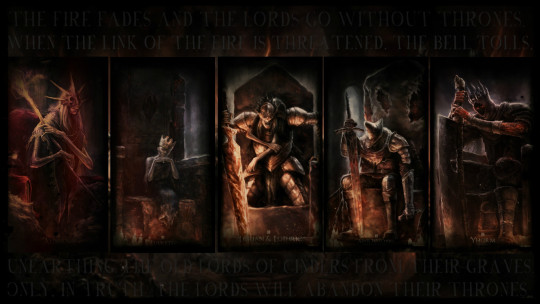
The Lords of Cinder are in many ways the primary adversaries of Dark Souls 3. This title they share, “Lord of Cinder,” refers to a personage who has rekindled the first flame, keeping the cycle of light and dark going.
Cinder is a substance which continues to burn without the presence of fire but does not reduce to ash. So euphemistically, it seems that the Lords are somehow stuck in their process of purification, and the game suggests that the world is stuck along with them; this is why it is the Ashen One’s task to “set them upon their thrones”—to hurry them along and thus allow the world to follow its natural decline. As individual characters, each of these Lords represents a different attitude that complicates and prolongs the cycle.
Through these stubborn Lords the game is commenting on at least two things. On the metaphysical level, it reflects the Buddhist idea that certain attitudes keep people reincarnating over and over again, unable to extricate themselves from the material world of suffering (samsara). While on the metatextual level, the game is suggesting that certain attitudes keep players coming back to Dark Souls again and again, starting new games, making new builds and revisiting old files.
The idea there on the metaphysical side finds an easy analogy in Buddhist doctrine: the “three poisons,” the three root causes of suffering. These are hatred, greed, and delusion. What’s interesting is that these essential vices also fit pretty easily onto the different types of players that are being caricatured by the Lords. We’ll break these correspondences down in a second.
But First: Why Do They Correspond?
So we have these sets of three. Three lords, three poisons in Buddhism, three types of Souls players. How convenient. When we analyze art, we sometimes ask, “Huh, is this structure really there, or am I projecting it into the material?” And if the structure is really there, baked into the work, that doesn’t mean that it’s due to developer intention. Archetypal forms sometimes show up in work via an unconscious influence, be it due to the cultural milieu, personal psychology, or some a priori biological disposition of the human being.
And the thing about Dark Souls is that it’s an unusually honest piece of art, in that its creative team allows their own free associations and intuitions to show up in the work without too much self-censorship or questioning. They make space for a mystery to show up on its own terms, and in leaving its riddles unanswered, there is more space for discovery by the people who play it.
It should also be said that cultural ideas persist for a reason. Beneath the ethics and ideology of the people who originally named the Buddhist “three poisons,” there may be something timeless, something perennially descriptive of human nature. If that is the case, then it would make sense for this same triplicity to unfurl itself in other cultural products. So for one reason or another, these three poisons, these addictions, show up diegetically in the characters and are also expressed in player psychology.
I say all this just because sometimes I feel very aware of the disconnect between much of Souls lore discourse and the broader field of mythological study. Since we are gamers first, there may be this tendency to want to “solve” the lore, but that’s not what we’re doing here. Myth functions because it elaborates our experience of the world through affective resonance; it attaches images and characters and stories which help us anchor our own prelinguistic impressions of the world, cultivating our sensitivity there.
Anyway, let’s look at these Lords.
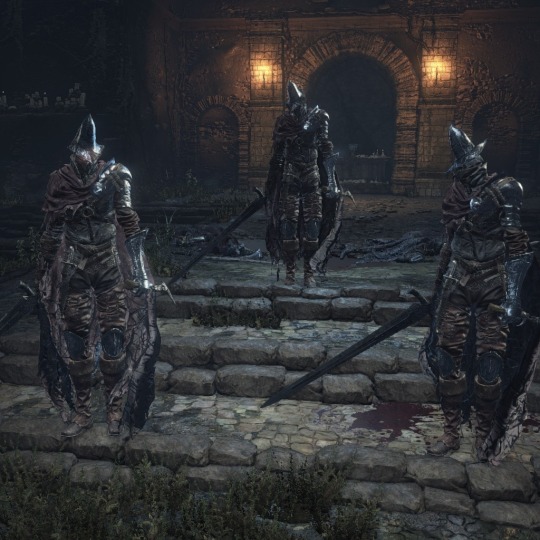
Abyss Watchers
Poison: Hatred
The lore of the Abyss Watchers is pretty clear: they have an obsessive fixation on the abyss, and are ready to raze an entire town if they suspect abyssal encroachment. This obsession has literally possessed them, as they are now “abyss touched.” Gaze too much into the abyss, etc. They carry such strong contempt for the disavowed object that they don’t care what comes between it and their sword. This is clearly demonstrated by the fact that they are a brotherhood yet are unhesitatingly slaughtering themselves again and again. Hatred has made them blind, and has also caused them to resign their individuality (they are identical, mere instruments of a transpersonal grudge). They cannot die, their hatred keeps them locked in combat.
Type of Player: competitive | Interest: combat
The Abyss Watchers are a representation of PvP addicts. They have no powers other than tenacity; they perform the same combos repeatedly. When you are really gripped by a PvP binge in Souls, you often end up doing the same thing again and again. The fight takes place in a mausoleum, on top of many chambers filled with human remains. The fact that this boss fight is instructional about combat, specifically about looking for tells (a cloud of dust always signifies the end of their combos) might be another clue. There is no limit to how good you get at Souls PvP; every foe is an opportunity to improve timing and strategy. You can just keep stacking anonymous bodies under yourself.
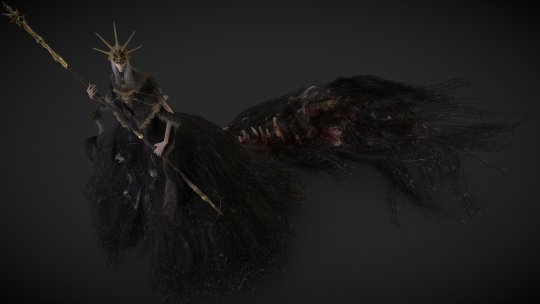
Aldrich
Poison: Greed
Aldrich invokes the concept of supremacy many times: he is in the supreme area from Dark Souls 1; in the supreme boss room of that area; he wears as a crown the former supreme lord of that area. This is because he devours lords; he tries to take prestige upon himself through acquisition and incorporation—greed.
Type of Player: completionist | Interest: content
Aldrich is a commentary on completionist players. He is someone who “plays the game to death”, acquiring every object, reaching every achievement, devouring the soul of the game through taking everything into himself. He becomes bloated by consuming as much of the game’s content as possible. The old God whose likeness he has adopted is Gwyndolin, who was, in narrative terms, the one pulling the strings in the land of the Gods. And in gameplay terms, he is a secret boss. So on both counts we have someone who is elusive, and exists more or less at the boundary of the gameworld. When a player tries to see every last little morsel of a game, they become somewhat like Gwyndolin, a manipulator of a virtual world. If you know too much about a game, you have the risk of being less immmersed.
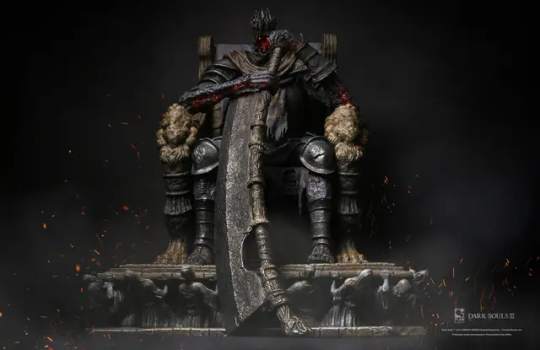
Yhorm
Posion: Delusion
In Buddhism, the poison of delusion secretly underlies the other two poisons, as the impulse toward hatred and greed are ultimately born of some false view about reality. This is akin to how the profaned capital sits below the rest of the kingdoms. To beat Yhorm you essentially have to “play pretend” with him, picking up a fake super-weapon, or fighting alongside Siegward, a knight who appears to be somewhat deluded about the state of the world, enthralled in the same fantasy as Yhorm himself.
Type of Player: lore researcher | Interest: meaning
The profaned capital is full of statues—fixed images of myth; and empty goblets—treasures with no utility. Not to mention the area with the swamp which is full of symbolic imagery, but serves no narrative or mechanical purpose. The entire profaned capital challenges us to make sense of it; it is the ultimate temptation of lorekeepers in DS3. It throws at us a disproportionate amount of reference to DS2, which is famous among Souls players as the least thematically sensible Souls game. The Greatshield of Glory is found right outside Yhorm’s room, in a conspicuous room full of treasure, and yet it is a very impractical shield and offers very little lore value. If a lore-minded player picks it up, it directs them to a legendary personage from the War of Giants, which raises far more questions than it answers. The same is true of much of this area—the Eleanora, the Monstrosities, the Profaned Flame itself—they are all there to get you to speculate. These are the players who come to Souls games again and again, trying to find the “ultimate meaning.” They seek the grail, claim to find it, and then chuck in a pile with the others.
Yhorm's story also imitates the primordial Artorias myth: forsaking his shield in preservation of something more valuable. Other than that Yhorm is largely a cipher when it comes to biography, with a void for a face, which itself epitomizes what must remain at the center of mythology and storytelling: mystery.
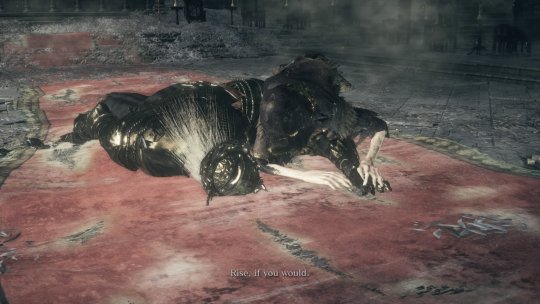
Sit Down and Seek Guidance
So we have the three reasons that people become fixated on Souls: the combat, the achievements, and the mystery. But there is a fourth lord of cinder boss, who is conceptually apart from these three: the Lothric Twins. They represent yet another kind of person who must keep playing Dark Souls: the developers. Lothric is striving to produce “a worthy heir,” a proper sequel to Dark Souls 1. The Princes are bound to their chamber as the developers are bound to their project, as that is their curse—“but you may rest here too, if you like.” In this context we can see their duality as the dual nature of having to work on the game and also play it to death. The privilege and the loftiness of the promise of a great piece of art (Lothric), and also having to go back "into the trenches" of the work itself (Lorian). Notably, neither of them can walk, they just teleport around. They are stuck at work, trying to bring the new world into being. Also I can’t go this whole essay without mentioning the obvious: that the Ashen One is bringing Lords to their thrones, and we players and developers have to assume our little chairs and couches when we access this world.
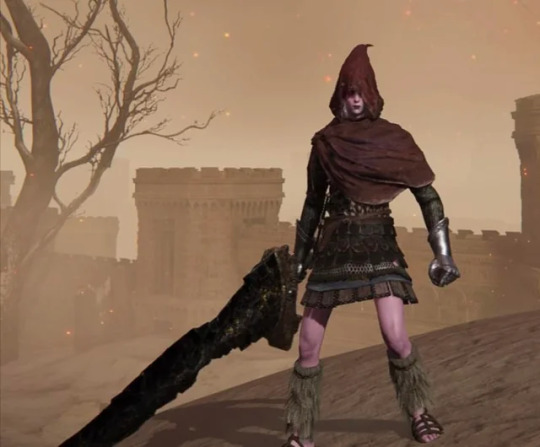
Playing Beyond the Point of Pleasure
Of course the most extreme example of someone stubbornly remaining in the world no matter what is Slave Knight Gael. He is looking for pigment, which seems to be a euphemism for the substance of humanity (the Dark Soul). He wants to give it to the painter, the world-creator, so that a new world can be made. He is willing to indulge in a wasteland of abject violence for as long as it takes in order to renew something. Ironic that he is probably only prolonging the current world in his obsessive drive to recycle it faster.
Let’s examine the relationship between the figure of the painter and her relationship to Gael. That she is a spiritual entity is obvious: we never see her touch the ground, she is always in an upper room and lifted on a piece of furniture. Among other things, she is a clear metaphor for life springing eternally. A creative child who continues to paint despite kidnapping and imprisonment. She is the heart of the painted world, itself a place that symbolizes the idea of the representation of reality.
I want to make sure this is clear, because it is a bit of a kaleidoscope to consider. Any subject in Dark Souls stands for many things, but something that the painted world specifically represents is the very concept of representation. So of course the places in our imaginations are painted worlds, but so is this physical world of appearance, the maya of mundane reality. Not to mention that a work of art is a painted world, and the game we’re discussing is a painted world. When a work of art is able to recreate itself in itself, we can see this funny effect of mirrors reflecting mirrors infinitely. This results in seemingly inexhaustible symbolic content—there is so much potential to find meaning and create connections. Because Moby Dick represents a work of literature; the Tempest represents a play; Twin Peaks represents a TV show, these works can offer extensive insights not only into their medium but into the nature of reality. In these and other examples, the representation of the medium within the work may or may not be a single subject, but since Dark Souls is formally a game about levels and level design, the painted world is the heart of its self-reflexivity. The painted world can be pointed to as the summary of this fractal device. And the personification of that device, its ambassador to the player, is the painter.
The miracle or divine child is also an archetype familiar to us from Lothric, in their struggle to produce the “worthy heir.” Reality seeks salvation through the appearance of grace. They want it in a clear, incontestable form—to be able to point at it and say, "thank goodness we went through all that, because look, now here is the meaning, here is that which validates all that came before." In the world of Dark Souls 3 the religion of the masses is the Lothric stuff; meanwhile knowledge of the painted world is much more obscure. Lothric’s religion is obviously regulated and hierarchical, while Gael’s devotion to the painter is highly personal and private: he carries around a scrap of painting; he prostrates to a hidden idol in a small chapel; he considers the painter his family. He is emotionally close to the object of his worship.
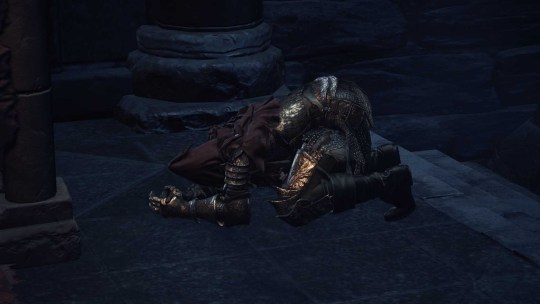
But whether it’s Lothric or Ariandel, they are anticipating the divine child to redeem the world. As an archetype, the child ultimately represents surprise. The possibility of being delighted by life in its creative novelty. The child as an archetype appears in our own behavior when we do something without any sort of contrivance or mental interference, doing something in the world which doesn’t seem to have come from who we conceive ourselves to be. This is miraculous. Such an action enchants the world, and there is no explaining it, even if it may weave all kinds of stories around itself, retroactively framing things that have led up to it as portents or promises. (Though not exclusive to him, this trait is well-known in characterizations of Christ, and DS3 is clearly indebted to Christian iconography, so do with that what you will). Regardless of the specific cultural invocation, the divine child is a personification of something that happens within the human spirit. TFW you are renewed by a fresh and spontaneous engagement with life.
The grace of the miraculous often comes to us through play. Play is more of an attitude than an activity; the feeling of play may come to us through making a painting, or chatting with a friend, or moving around in a video game. We can play video games idly, competitively, experimentally, creatively, studiously, whatever, the feeling of “play” can show up regardless. We can sit there playing a certain game from a certain motivation, and feel totally rote and joyless, and question, “Why am I doing this?” Or we might sit there and play the same game with the same motivation, feeling totally lit up by it, its purpose to us obvious and self-validating. We are not even questioning why we are doing it, we are enjoying life.
This is really the ground that the miraculous tends to land on. Grace, meaning, and an immanent love of life are more likely to show up when we are in flow and not exercising our capacity for self-assessment. But like everything in life, we mistake the images and objects around us for the feeling of grace. Any given object might only be the catalyst once; it’s not about the object. This is extremely easy to see in cases of acute nostalgia; adults chase enchantment through collecting Zelda memorabilia or going to Disneyland, in pursuit of what kindled their spirit as a child. It was never really the game or the character that was doing it, it was what they were able to access within themselves.
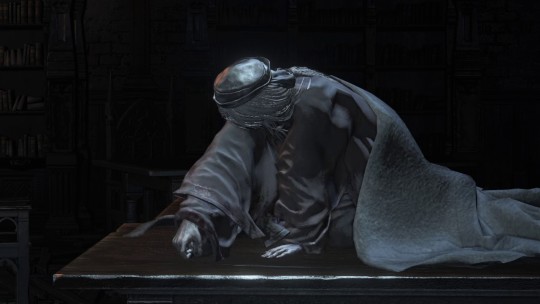
So anyway Gael has yet to realize this. He thinks the Dark Soul is out there in something else. That it will be yielded as a drop if he just kills the right enemy, or 10,000 enemies, or goes to the right place at the right time. You can see that this is something of a synthesis of all the other Buddhist defilements: there are elements of completionism/greed, violence/hatred, mysticism/delusion. There is even the suggestion of the developer of these games again, in that Gael is a “slave,” forced into participation in the world to assist some creative apotheosis. (Isn’t it funny that his weapon is a worn-down executioner’s sword?—whether the person coding or the person playing, we are all “executing” command after command). The thing that really keeps him on the wheel is something beyond any of the player types and their vices; it is almost some sort of pure, amoral automatism, a churning drive that on one side resembles wanton nihilism, and on another side single-minded piousness. Is one disguised as the other, or has Gael somehow stepped beyond this binary? Yet another dichotomy in Dark Souls that begs to be reconciled, but whose tension creates the opportunity to participate creatively in its expansive mythology. When things are held apart we can move between them.
To really understand Gael, we have to contend with the question of a person’s relationship to their own soul, since that relationship is so plainly suggested by Gael and the painter. (This question, by the way, is much elaborated in Elden Ring, with its repeated foregrounding of the image of the maiden or “consort”). If we were to see Gael and the painter as partitions within one person--whether she is his soul, or his inner life, or his better nature, whatever—then in any case Gael is the side which goes out into the world and experiences it. He is the creative extension into the world as its active participant and realizer. Yet he is clothed as the warrior, the executioner. While the one who is dressed as the artist, the painter, just stays in her room and imagines the world—but this is where the magic of creation is really felt. We involve ourselves in life, or in a game, but we are only really changed and renewed when that exterior experience is “brought home” into the inner life. We do something “in the game,” but the act of “painting,” in renewing the world through our creative interpretation, is a decidedly interior experience.
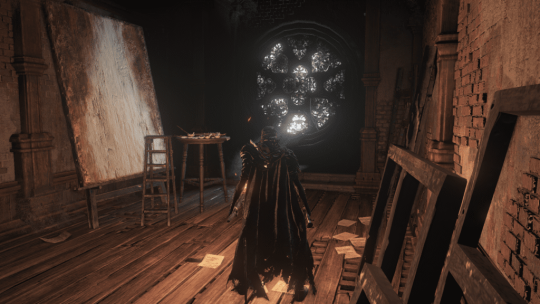
#dark souls#dark souls 3#lords of cinder#game entrainment#dark souls analysis#dark souls lore#ariandel#slave knight gael#the painted world
74 notes
·
View notes
